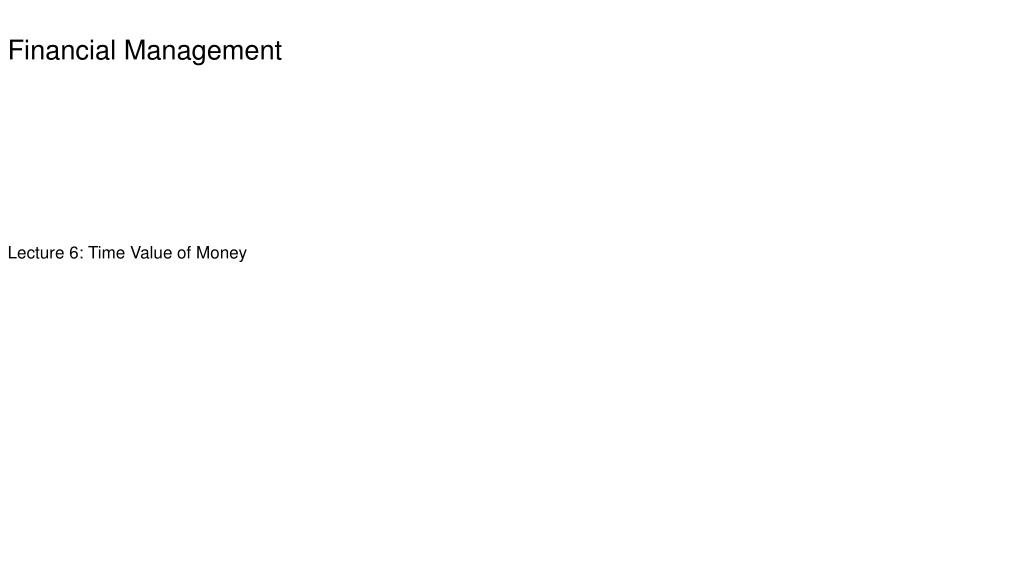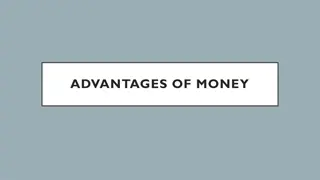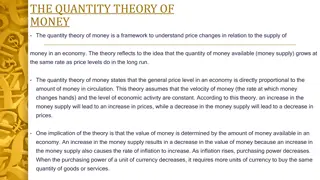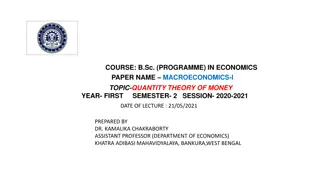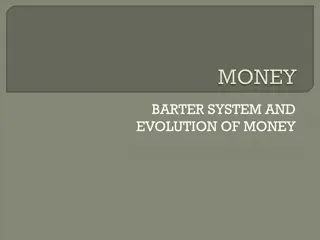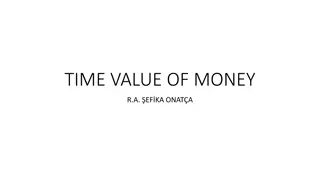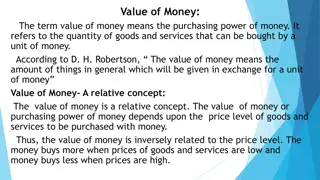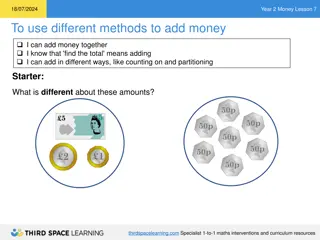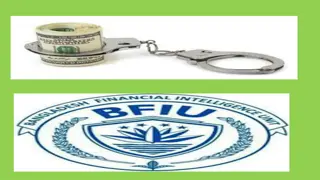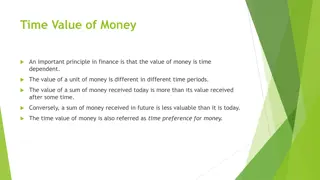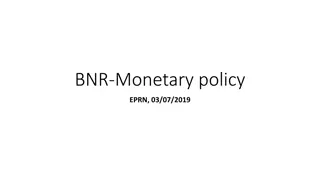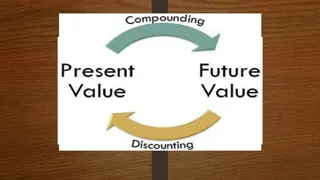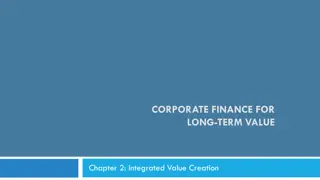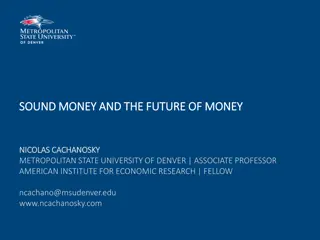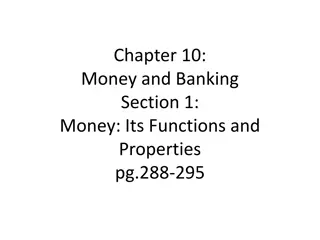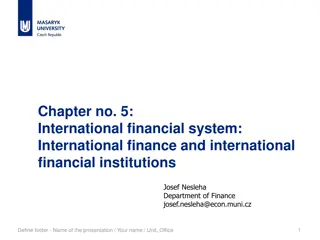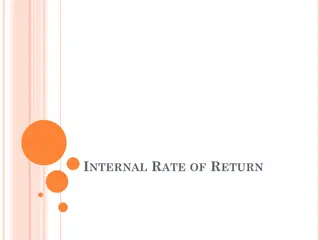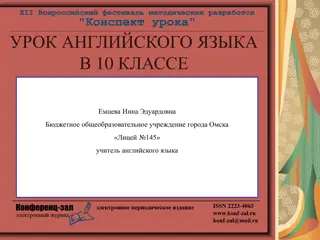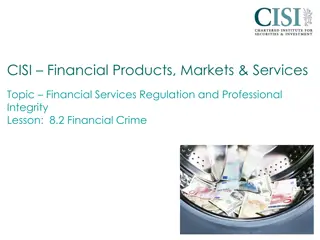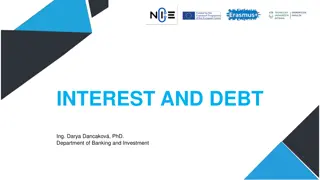Understanding Time Value of Money in Financial Management
Explore the concepts of time value of money, financial decision-making, and valuation decisions in the field of finance. Learn how to analyze costs and benefits, make informed financial choices, and use market prices to determine cash values. Dive into scenarios involving trade-offs and opportunity costs to enhance your financial acumen.
Download Presentation

Please find below an Image/Link to download the presentation.
The content on the website is provided AS IS for your information and personal use only. It may not be sold, licensed, or shared on other websites without obtaining consent from the author. Download presentation by click this link. If you encounter any issues during the download, it is possible that the publisher has removed the file from their server.
E N D
Presentation Transcript
Financial Management Lecture 6: Time Value of Money
Financial Decision Making Pre-Test: Which of the following amounts would you rather have? A. A$1000 today B. A$1050 in one year if the interest rate is 10% C. 730 if 1.00=A$1.30 D. 0.60 ounces of gold if gold is worth A$1600/oz E. No idea how to compare! k FINM7409
Three Basic Ideas in Finance 1. Time Value of Money 2. Arbitrage / Law of One Price 3. Diversification FINM7409
Valuation Decisions Identify Costs and Benefits Will require input from Marketing, Economics, Organisational Behaviour, Strategy, Operations, etc. Costs and Benefits must be compared at the same point in time By convention we usually choose today (present value) Costs and Benefits must be compared using the same measure By convention we usually choose domestic currency (A$) FINM7409
Analysing Costs and Benefits Suppose a jewellery manufacturer has the opportunity to trade 35 ounces of platinum and receive 30 ounces of gold today. To compare the costs and benefits, we first need to convert them to a common unit. FINM7409
Analysing Costs and Benefits If gold is worth $1750/ounce, then (30 oz. of gold) X ($1750/oz.) = $52,500 today If platinum is worth $1600/ounce (35 oz. platinum) X ($1600/oz.) = $56,000 today So, this opportunity has a benefit of $52,500 today and a cost of $56,000 today. Net value = benefit cost = $3,500 Net value is negative, the costs exceed the benefits and the jeweller should reject the trade. FINM7409
Using Market Prices to Determine Cash Values Competitive Market A market in which goods can be bought and sold at the same price. In evaluating the jeweller s decision, we used the current market price to convert from ounces of platinum or gold to dollars. We did not concern ourselves with whether the jeweller thought that the price was fair or whether the jeweller would use the silver or gold. FINM7409
Try It Your car recently broke down and it needs $2,000 in repairs. But today is your lucky day because you have just won a contest where the prize is either a new motorcycle with a MSRP of $15,000, or $10,000 in cash. You do not have a motorcycle license, nor do you plan on getting one. You estimate you could sell the motorcycle for $12,000. Which prize should you choose? A. Motorcycle B. $10,000 cash C. Depends on whether I want a motorcycle D. Where do I start? k FINM7409
Example You are offered the following investment opportunity: In exchange for $40,000 today, you will receive 2,500 shares of stock in the Ford Motor Company and 10,000 euros today. The current market price for Ford stock is $9 per share and the current exchange rate is $1.50 per . Should you take this opportunity? FINM7409
Solution Benefits: Ford Stock Euros 2,500 $9= $22,500 10,000 $1.50=$15,000 $37,500 $40,000 $2,500 Total Costs: Benefits Costs: FINM7409
Follow up Would your decision change if you believed the value of the euro would rise over the next month? A. Yes, we should use next year s euro exchange rate in our computation because we plan to hold our investment for a year B. Yes, that will increase our return from holding the euros C. No, only today s prices matter D. No, higher euro value will reduce the demand for Fords in Europe, so there will be no change in the total value of Ford + euros k FINM7409
Time Value of Money Consider an investment opportunity with the following certain cash flows. Cost: $100,000 today Benefit: $105,000 in one year We can t compare dollars today directly with dollars in the future. There is a time value to having money today that makes $1 today worth more than $1 in one year FINM7409
The Interest Rate: An Exchange Rate Across Time The rate at which we can exchange money today for money in the future is determined by the current interest rate. Suppose the current annual interest rate is 7%. By investing or borrowing at this rate, we can exchange $1.07 in one year for each $1 today. Risk Free Interest Rate (Discount Rate), rf: The interest rate at which money can be borrowed or lent without risk. Interest Rate Factor = 1 + rf Discount Factor = 1 / (1 + rf) FINM7409
The Interest Rate: An Exchange Rate Across Time Will we invest? Cost = $100,000 today, Benefit = $105,000 in one year If the interest rate is 7% Cost = ($100,000 today) (1.07 $ in one year/$ today) = $107,000 in one year Since we will have more if we put our $100,000 in the bank, we will NOT invest Benefit Cost = $2000 in one year FINM7409
The Interest Rate: An Exchange Rate Across Time Will we invest? Cost = $100,000 today, Benefit = $105,000 in one year If the interest rate is 7% Benefit = ($105,000 in one year) (1.07 $ in one year/$ today) = $98,130.84 today Since the bank will only lend us $98,130.84 today for $105,000 in a year, we will NOT invest Benefit Cost = $1869.16 today FINM7409
Present Versus Future Value If we convert from dollars today to dollars in one year, ( $1869.16 today) (1.07 $ in one year/$ today) = $2000 in one year. The two results are equivalent, but expressed as values at different points in time. FINM7409
Present Versus Future Value When we express the value in terms of dollars today, we call it the present value (PV) of the investment. When we express the value in terms of dollars in the future, we call it the future value (FV) of the investment. FINM7409
Discount Factors and Rate 1 + 1 = = 0.93458 We can interpret 1 r 1.07 1 + as the price today of $1 in one year. The amount is called the one- year discount factor. 1 r The risk-free rate is also referred to as the discount rate for a risk-free investment FINM7409
Try It The cost of replacing a fleet of company trucks with more energy efficient vehicles was $100 million in 2011. The cost is estimated to rise by 8.5% in 2012. If the interest rate was 4%, what was the cost of a delay in terms of 2011 dollars? A. $8.50m B. $4.33m C. $8.17m D. $4.0m k FINM7409
Solution If the project were delayed, its cost in 2012 would be: $100 million (1.085) = $108.5 million Compare this amount to the cost of $100 million in 2011 using the interest rate of 4%: $108.5 million 1.04 = $104.33 million in 2011 dollars. The cost of a delay of one year would be: $104.33 million $100 million = $4.33 million in 2011 dollars. FINM7409
Converting Between Dollars Today and Gold, Euros, or Dollars in the Future FINM7409
Pre-Test You ve been promised $2000 in 2 years. Which formula would you use to compute the value of that promise today? Assume the relevant interest rate is 3% p.a. (compounded annually). =2000 1.06 A. , C. , PV = 2000(1.06) PV 2000 1.03 B. D. , 2 = PV 2000(1.03) = PV 2 k FINM7409
The Timeline Assume that you are lending $10,000 today and that the loan will be repaid in two annual $6,000 payments. Year 1 Year 2 Date 0 1 2 $10,000 Cash Flow: $6000 $6000 Today End Year 1 Begin Year 2 The first cash flow at date 0 (today) is represented as a negative number because it is an outflow. FINM7409
Three Rules of Time Travel Financial decisions often require combining cash flows or comparing values. Three rules govern these processes. Table 4.1 The Three Rules of Time Travel FINM7409
The 1st Rule of Time Travel It is only possible to compare or combine values at the same point in time. Which would you prefer: A gift of $1,000 today or $1,210 at a later date? To answer this, you will have to compare the alternatives to decide which is worth more. How long is later? FINM7409
The 2nd Rule of Time Travel To move a cash flow forward in time, you must compound it. Suppose your choice is between receiving $1,000 today or $1,210 in two years. You believe you can earn 10% on the $1,000 today. Step 1: Construct a timeline: years 0 1 2 A: B: $1000 $1210 FINM7409
The 2nd Rule of Time Travel Step 2: Move cash flow forward by compounding years 0 1 2 $1000 $1100 $1210 1.10 1.10 Future Value of a Cash Flow: FINM7409
Example Suppose you have a choice between receiving $5,000 today or $10,000 in five years. You believe you can earn 10% on the $5,000 today, but want to know what the $5,000 will be worth in five years. Use the formula FV=PV(1+r)^n. Which of these is wrong? A. PV=5000 B. n=5 C. FV=10000 D. r=0.10 FINM7409
Solution 0 1 2 3 4 5 $5,000 $5,500 $6,050 $6,655 $7,321 $8,053 1.10 1.10 1.10 1.10 1.10 1.1 = $8,052.55 5 5000 $5,000 today is worth $8,053 in 5 years Better off taking $10,000 in 5 years FINM7409
The 3rd Rule of Time Travel To move a cash flow backward in time, you must discount it. Present Value of a Cash Flow: C ( ) ( ) n n = + = = + PV C 1 r C 1 r ( ) n + 1 r FINM7409
Computing Present Values Suppose you are offered an investment that pays $10,000 in five years. If you expect to earn a 10% return, what is the value of this investment today? 0 1 2 3 4 5 $6,209 $6,830 $7,513 $8,264 $9,091 $10,000 1.10 1.10 1.10 1.10 1.10 = $6,209.21 10000 1.1 5 $10,000 in five years is worth $6,209 today FINM7409
Applying the Rules of Time Travel Rule 1: It is only possible to compare or combine values at the same point in time. So far we ve only looked at comparing. Suppose we plan to save $1000 today, and $1000 at the end of each of the next two years. If we can earn a fixed 10% interest rate on our savings, how much will we have three years from today? FINM7409
Combining Values 0 1 2 3 $1000 $1000 $1100 $2100 $1000 ? 1.10 $2310 $3310 1.10 $3641 1.10 OR 0 1 2 3 $1000 $1000 $1000 ? $1331 $1210 $1100 1.103 1.102 1.10 $3641 FINM7409
Valuing a Stream of Cash Flows Based on the first rule of time travel we can derive a general formula for valuing a stream of cash flows: if we want to find the present value of a stream of cash flows, we simply add up the present values of each. 0 1 2 N C C C C 0 1 2 N C N n ( ( ) ) = PV 1 n r + C 1 r ( ) n 1 + 0 1 = 2 + C 1 r 2 ... ( ) N + C 1 r N FINM7409
Future Value of Cash Flow Stream 0 1 2 N C C C C ... 0 1 2 N ( ( ) ) N 2 + C 21 r N 1 + C 11 r ( ) N + C 01 r N n ( ) ( ) N n N = + FV C 1 r = + FV PV 1 r N n N = 0 FINM7409
Example You have the opportunity to purchase an investment that will pay $2000 at the beginning of each year for three years. You can earn 5% per year on a comparable investment What is the current value of this investment? FINM7409
Solution 0 1 2 3 $2000 $2000 $2000 2 2000 1.05 2000 1.05 2000 1.05 = = + + PV 2000 ( ) ( ) n 2 = n 0 = + + 2000 1904.76 1814.06 = 5718.82 FINM7409
And How much will you have at the end of the third year if all cash flows are reinvested at 5%? 3 = ( ) n 3 FV C 1.05 3 n = n 0 ( ) ( ) ( ) 3 2 = + + + 2000 1.05 2000 1.05 2000 1.05 0 = + + = 2315.25 2205 2100 6620.25 ( ) ( ) 3 3 = = = 6620.25 FV PV 1.05 5718.82 1.05 3 FINM7409
Compounding and Interest Rate FINM7805 39
The effective annual interest rate The National Consumer Credit Protection Act (2009) requires that Annual Percentage Rates (APRs) be disclosed on all consumer loans and savings plans, and prominently displayed on advertising and contractual documents This means that interest rates are quoted as APRs. APR is the simple interest accrued on loan or investment in a single period and annualised by multiplying it by the appropriate number of periods in a year Example: a APR would be quoted as 12% p.a. compounding monthly p.a. means per annum i.e. every year In this example, interest is earned or paid every month at a rate of 1% per month 40
The effective annual interest rate However, APRs are NOT the appropriate rate to use in present and future value calculations APR does not accurately reflect the actual interest earned or paid Example: if you had $100 and invested it for one year at a rate of 12% p.a. compounding monthly, how much would you have at the end of the year? What rate of return have you earned on your money? You have earned an effective rate of 12.68% instead of 12% 41
The effective annual interest rate As you can see from the prior slide, APR does not reflect the true rate of return Why? Because APRs do not take compounding into account Therefore we often cannot use APRs directly to work out the discount rate for time value of money problems We need to convert APRs into a rate that accurately reflects the total compound interest earned or paid on an investment We can convert any APR into an annual rate which incorporates compounding by using the following formula ? 1 + ??? = 1 +??? This will give us the Effective Annual Return (EAR) the annual return which includes compounding , where k is the number of compounding periods per year. ? 42
A quick summary The annual percentage rate (APR) indicates the amount of simple interest earned in one year. Simple interest is the amount of interest earned without the effect of compounding. In Australia, if an investment quotes as per annum (p.a.) rate, this is generally an APR. This is what we observe. The effective annual rate (EAR) indicates the total amount of interest that will be earned at the end of one year. (with the effect of compounding) 43
Example with APR=6% The EAR increases with the frequency of compounding. Continuous compounding is compounding every instant. When k gets very large, EAR approaches its limit. 44
APR Discount Rate (?) The interest rate needs to be consistent with the cash flow interval. e.g., monthly interest rate with monthly cash flows The APR itself cannot be used directly as a discount rate unless we have yearly cash flows. If the interest rate compounding frequency is the same as cash flow interval, then we can use ????=??? For example, if the interest rate is 12% compounding monthly, and we are calculating the future value of monthly payments, then the discount rate is 12%/12=1% However, if the cash flow interval is quarterly, we cannot use 12%/4=3%, as the actual interest earned over the quarter is more than 3% due to monthly compounding ? 45
EAR Discount Rate We could also ask: What if we know the EAR of an investment, how can we calculate the discount rate per period? 1 ? 1 ????= 1 + ??? k is the number of compounding periods in a year. E.g. What is the monthly discount rate to have an EAR of 5%? (1.05)1/12 1= 1.00407 1 = .00407 = 0.407% It means that if you earn 0.407% every month, you would earn 5% for the entire year (EAR). 1 ? 1 ? Recall: 1 + ??? = 1 + ???? ????= 1 + ??? 46
The effective annual interest rate When you are faced with a time value of money question, you need to look at three things: Cash flows Discount rate Time You need to match the timing of the cash flows and the compounding frequency of the discount rate The frequency of cash flows determines the time periods that need to be used 47
The effective annual interest rate Example: You have just bought a new car and taken out a loan . You will make annual payments for a car for three years. You have been quoted a rate of 6% p.a. compounding monthly Does the timing of the cash flows and the rate match? NO the cash flows are annual, but the loan compounds monthly So to do this calculation, you first need to convert the monthly APR into an EAR 48
The effective annual interest rate We can use this concept to convert any rate from one compounding frequency to another Example: You want to buy a new TV and are considering two options. The first is you will pay $1,500 today. The second option is to make a payment plan where you will make monthly payments of $100 for two years, starting at the end of this month. You have been quoted a rate of 6% p.a. compounding quarterly. Let us consider the payment plan first How frequently are payments made? How frequently does the rate compound? Do these two match? What do we need to do? 49
The effective annual interest rate What is the quarterly rate? Monthly rate? Quarterly rate =0.06/4 = 0.015 1 3-1 = 0.0049752 Which option should you choose? (1 + 0.015) Payment plan: 1 1 (1+0.0049752)24 0.0049752 PV = 100 =$2256.97 You should pay the $1500 today 50
